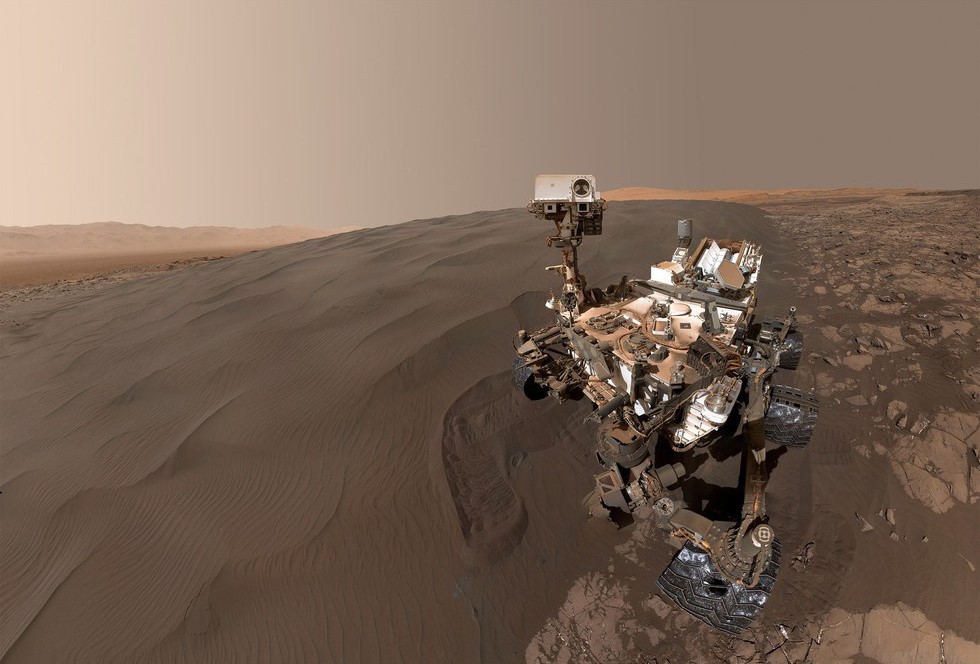
For the silver foxes among us, we may remember where we were when JFK died or when Challenger breathed her last in the skies above the Kennedy Space Center (KSC). But for NASA’s Curiosity rover—which alighted on Mars, inside the yawning bowl of Gale Crater, five years ago, today—its recollection is forever imprinted. “Five years ago tonight,” the mission tweeted Saturday, “I was rappelling out of a jetpack onto the surface of #Mars. Where were you?”
Sixty months ago, the world watched and waited for the moment of truth, as many years of planning and preparation yielded to the “Seven Minutes of Terror”. High above the plains of Mars, the incoming Curiosity rover was about to become the United States’ fourth successfully operator rover to land and traverse the surface of the Red Planet. However, unlike its predecessors—Sojourner, Spirit and Opportunity—the large size and mass of Curiosity meant that an airbag-cushioned touchdown was out of the question.
Instead, the 1,980-pound (900 kg) rover depended upon a complex arrangement of parachutes, retrorockets and a never-before-tried “Sky Crane” to guide it to a pinpoint landing within the 96-mile-wide (154 km) Gale Crater. In an event which proved as much of a miracle as a technological triumph, it succeeded, and Curiosity’s first five years have revolutionized our understanding of Mars, so much so that in December 2012 its mission was extended indefinitely.
Since then, the plucky rover has traveled more than ten miles (15 km), acquired over 200,000 images and yielded tantalizing clues of a warmer, wetter past for Mars. It has drilled 15 rock samples and its list of discoveries includes confirmation that lakes once flowed in Gale Crater, that the planet itself had an oxygen-rich atmosphere and offered exciting evidence of ancient organics and the possibility of microbial life.
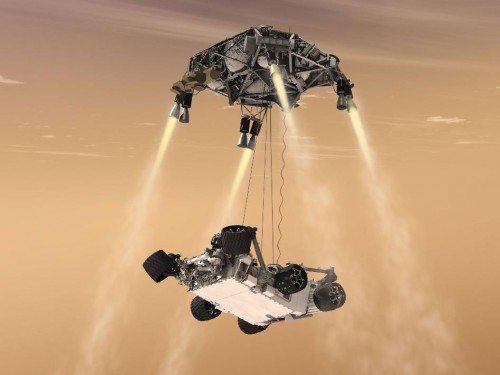
Curiosity’s journey to Mars began from Space Launch Complex (SLC)-41 at Cape Canaveral Air Force Station, Fla., in November 2011, atop a United Launch Alliance (ULA) Atlas V booster. A little over eight months later, on the night of 5/6 August 2012, it was readied for the perilous, seven-minute-long Entry, Descent and Landing (EDL) maneuver, which placed it within a “landing ellipse” of just 12 x 4.3 miles (19.3 x 6.9 km), far narrower than anything attempted by any previous mission. Throughout the process, Curiosity operated autonomously, according to pre-loaded software parameters, and was watched “live” by an estimated 3.2 million people on NASA TV, cable networks and online.
Folded within an “aeroshell” for the bulk of its voyage to Mars, Curiosity separated from its cruise stage about ten minutes ahead of atmospheric entry. Shortly thereafter, thrusters on the aeroshell were fired to cancel out the spacecraft’s slow rotation and the process of entering Mars’ atmosphere began. Protected by a 15-foot-wide (4.6-meter) heat shield of phenolic impregnated carbon ablator, the cocooned rover survived peak temperatures of 2,090 degrees Celsius (3,790 degrees Fahrenheit) and a maximum deceleration of around 15 G. Ejectable ballast mass weights were deployed at several key stages during entry, and reaction control thrusters were fired to provide the aeroshell with sufficient “lift” during this highly dynamic phase.
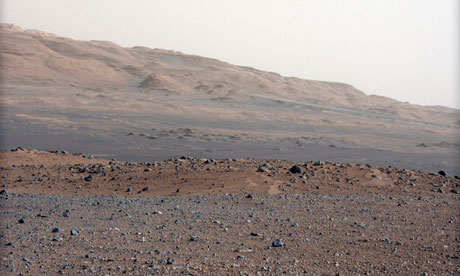
Within minutes, the incoming spacecraft had slowed to Mach 1.7, and at an altitude of about 6.2 miles above the surface, a 52-foot-diameter (16-meter) parachute was deployed, after which the heat shield separated. NASA’s Mars Reconnaissance Orbiter (MRO), orbiting high above the planet, photographed the parachute deployment. Falling further into the atmosphere, the rover and its descent stage separated from the aeroshell at a velocity of 220 mph (354 km/h) and an altitude of 1.1 miles (1.7 km).
The descent stage consisted of a platform above Curiosity, armed with eight hydrazine engines, which provided 90-700 pounds (40-320 kg) of variable thrust to slow the descent, after which the Sky Crane lowered the rover with a 25-foot-long (7.6-meter) tether to a soft, wheels-down landing on the red-hued surface. After detecting and confirming “Weight on Wheels”, a series of pyrotechnic charges cut cables to free Curiosity from the descent stage, which then flew away to a crash landing about four miles (6.4 km) away.
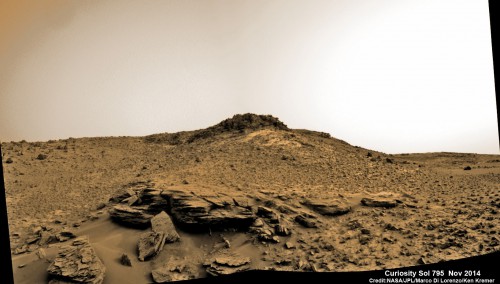
Simply reading that description of Curiosity’s arrival on Mars makes it all the more remarkable that it was pulled off at all, let alone that it was pulled off entirely without incident, although not without a certain amount of nail-biting tension on the part of the mission control team and space enthusiasts around the world. Curiosity achieved Weight on Wheels on the Martian surface at 10:17 p.m. PDT on 5 August (1:17 a.m. EDT on 6 August 2012) and touched down less than 1.5 miles (2.4 km) from its target…after a 350-million-mile (563-million-kilometer) journey. Firm confirmation of its successful landing reached the ears of an exuberant flight control team about 14 minutes later.
Its landing site was Gale Crater, an enormous impact basin, estimated at somewhere between 3.5 and 3.8 billion years old. Within the crater lies the forbidding 18,000-foot (5,500-meter) peak of Aeolis Mons (“Mount Sharp”). And here, for the last five Earth-years, Curiosity has conducted a truly astounding program of scientific observation and discovery which the whole world has had the opportunity to share and experience.
“We now know Mars offered favorable conditions for microbial life, billions of years ago,” said Curiosity Project Scientist John Grotzinger of the California Institute of Technology in Pasadena, Calif. “It has been gratifying to succeed, but that has also whetted our appetites to learn more. We hope those enticing layers at Mount Sharp will preserve a broad diversity of other environmental conditions that could have affected habitability.”
Be sure to “LIKE” AmericaSpace on Facebook and follow us on Instagram & Twitter!
.





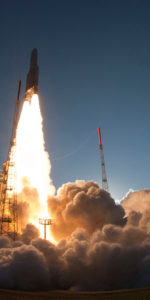
Please excuse the off topic reply; have you stopped your weekend manned spaceflight history articles?
Hi Robert,
We have not, but have however scaled back our weekend history series for the time being to one history story each Sunday.
Managing Editor
Looks like the shuttle played a part as well
https://www.space.com/37716-space-shuttle-regulator-mars-curiosity-landing.html
The entire landing of this large piece of equipment is amazing and yet with the cancellation of the SpaceX Red Dragon there does not seem to be any further testing to land any larger craft on the planet…Seems like NASA does not want to know much more about the planet too quickly.
Anything bigger than MSL requires a new landing method all together. While the sky-crane was an incredible achievement to pull off on another world, done completely autonomously too, it is far too great a risk for larger and heavier vehicles. Part of the reason behind the Low-Density Supersonic Decelerator test campaign:
The Low-Density Supersonic Decelerator (LDSD) has its place (for instance on the ULA Vulcan engine module recovery system), however the LDSD is somewhat heavy, complex and ineffective for Mars entry or aerocapture.
NASA is investing (not enough thanks to SLS/Orion -but I digress) in two other promising entry/capture technologies, the Transformable Hypersonic Aerodynamic Decelerator and the Magnetoshell.
Most people will instantly recognize the Transformable Hypersonic Aerodynamic Decelerator from Bob Zubrin’s Mars Direct, this is the “umbrella” aerobrake used for Mars entry of the Hab modules. Project links below:
https://technology.nasa.gov/patent/TOP2-162
https://youtu.be/f_eWC7OZx2E
The more exotic atmospheric brake is the Plasma Aerocapture and Entry System aka Magnetoshell
The Magnetoshell sounds too-good-to-be-true, but it is in fact feasible. Project links below:
https://www.nasa.gov/directorates/spacetech/niac/2012_phase_I_fellows_kirtley.html
https://youtu.be/E2r_q38JsJ4
Incidentally:
Aerobreak technology like the Magnetoshell or Transformable Hypersonic Aerodynamic Decelerator, is also on the critical path for any lunar derived propellant scheme. The most valuable market for lunar propellant would be in low earth orbit (LEO), but delivering this propellant to LEO using a propulsive breaking maneuver is a loosing proposition, leading to the great Lunar Catch-22.
A cheap, disposable, space manufacturable aerobreak would be a dream-come-true for dropping lunar propellant into LEO. A version of the Transformable Hypersonic Aerodynamic Decelerator (without the transformable part) might be the hot ticket, if it can be made mostly on the moon from native lunar materials.
The native lunar materiel of choice? Basalt. Good old igneous Basalt (dark volcanic rock) is an amazingly versatile building material. This is a surprise to most Americans, but in Eastern Europe basalt is a common industrial feed stock, mostly thanks to lots of cheap electricity from Soviet era nuclear reactors.
Basalt yarn can be woven into a tough, high-temperature fabric that is ideal for aerobrakes.
Below is a link to Basalt Fabric dot com:
https://basalt-fabric.com/
Finally: cool things like basalt aerobrakes, space tethers, lunar ice mines and so on, will require 100s of $billions in up-front investment in tech and infrastructure, before a single dollar of profit is ever realized. Therein lies the great lunar Catch-22; a kilogram of LOX/H2 delivered to LEO must cost less that that same LOX/H2 delivered to LEO by reusable SpaceX/BO launch vehicles. And -the very process of lifting that infrastructure to the Moon by SpaceX/BO will, by virtue of economics of scale, lower the marginal cost of launching LOX/H2 from the earth even more, making the Catch-22 worse. Of course, one can a assume all that infrastructure will be sent to the moon on a hyper-expensive (70% overhead) government rocket that launches once a year, but that would be…oh never mind.
The Low-Density Supersonic Decelerator (LDSD) has its place (for instance on the ULA Vulcan engine module recovery system), however the LDSD is somewhat heavy, complex and relatively ineffective for Mars entry or aerocapture.
NASA is investing (not enough thanks to SLS/Orion -but I digress) in two other promising entry/capture technologies, the Transformable Hypersonic Aerodynamic Decelerator and the Magnetoshell.
Most people will instantly recognize the Adaptable Deployable Entry Placement Technology (ADEPT) from Zubrin’s Mars Direct, this is the “umbrella” aerobrake used for Mars entry of the Hab modules.
To learn more about ADEPT, go to technology.nasa.gov and and search for /patent /TOP2-162Project
To see a video of the work at NASA Ames, search on YouTube for: NASA Ames Completes Successful Heat Shield Testing for Future Mars Exploration Vehicles
The more exotic atmospheric brake is the Plasma Aerocapture and Entry System aka Magnetoshell
The Magnetoshell sounds too-good-to-be-true, but it is in fact feasible.
To learn more about the Magnetoshell, go to the NASA NIAC page, and search for: Plasma Aerocapture and Entry System
To see a YouTube video on the project, search for David Kirtley, A Plasma Aerocapture and Entry System
Real shame in my opinion that NASA overlooked Mars Direct for so long, Zubrin is a trailblazer for humans on Mars and I hope history remembers him for it. Unfortunately I do not think it will…
…cancellation of the SpaceX Red Dragon there does not seem to be any further testing to land any larger craft on the planet…Seems like NASA does not want to know much more
The Red Dragon was an in-house SpaceX project, not a NASA project.
We can look forward to a larger “Red Ice Cream Cone” unmanned Mars lander test project in the near future, “Ice Cream Cone” being the biconic type vehicle that SpaceX will use for its manned Mars landers.
Instead of plowing more-or-less strait into the atmosphere, a biconic lander “flies” a very shallow entry corridor a long way around the planet. The biconic offers lower g forces on the crew, lower max heat loads, the ability to steer a lot of cross-range, and better internal hardware packaging.
SpaceX has, of course, already demonstrated (routine now) the hypersonic flip over, retro-burn and tail sitter landing that was always considered the hard part of this flight technology.
below are some links to renderings + info about biconic Mars landers:
https://tinyurl.com/jkj9dfo
http://www.frassanito.com/work/images/planning02.jpg
http://old.marssociety.org.au/amec2002/proceedings/06-MarsOz_background_full_paper.htm
“…cancellation of the SpaceX Red Dragon there does not seem to be any further testing to land any larger craft on the planet…Seems like NASA does not want to know much more”
The Red Dragon was an in-house SpaceX project, not a NASA project.
We can look forward to a larger SpaceX “Red Ice Cream Cone” unmanned Mars lander test project in the near future, “Ice Cream Cone” being (my temporary name for) the biconic type vehicle that SpaceX will use for its manned Mars landers.
Instead of plowing more-or-less strait into the atmosphere, a biconic lander “flies” a very shallow entry corridor a long way around the planet. The biconic offers lower g forces on the crew, lower max heat loads, the ability to steer a lot of cross-range, and better internal hardware packaging.
SpaceX has, of course, already demonstrated (routinely now) the hypersonic flip over, retro-burn and tail sitter landing that was always considered the hard part of this flight technology.
below are some links to renderings + info about biconic Mars landers:
MarsHome dot org and search for 9_landing_0.jpg in the image gallery
The Mars Society Australia has a great paper on biconics, go to hteeteepee://old.marssociety.org.au/amec2002/proceedings/06-MarsOz_background_full_paper dot htm
se jones
Thanks for the update…
“Instead of plowing more-or-less strait into the atmosphere, a biconic lander “flies” a very shallow entry corridor a long way around the planet. The biconic offers lower g forces on the crew, lower max heat loads, the ability to steer a lot of cross-range, and better internal hardware packaging.”
I am concerned though …Doesn’t a horizontal entry cause plasma disturbances within the atmosphere that can lead to discharge like what destroyed the Columbia Shuttle?
se jones
Thanks for the update…
“Instead of plowing more-or-less strait into the atmosphere, a biconic lander “flies” a very shallow entry corridor a long way around the planet. The biconic offers lower g forces on the crew, lower max heat loads, the ability to steer a lot of cross-range, and better internal hardware packaging.”
I am concerned though …Doesn’t a horizontal entry cause plasma disturbances within the atmosphere that can lead to discharge like what destroyed the Columbia Shuttle?
“…horizontal entry cause plasma disturbances within the atmosphere that can lead to discharge like what destroyed the Columbia Shuttle?”
It seems that you’re implying that there’s a sudden “discharge” like a lightning bolt. No, the air is compressed and becomes so hot it’s ionized (becomes a plasma) all along the entry path at hyper-velocity (>≈mach 10) speeds. A more horizontal entry, like the Space Shuttle or a Mars biconic lander, generates slightly lower temperatures, but for a longer period of time than a steeper entry like Apollo returning from the Moon.
It took 16 minutes while the hot plasma “leaked” into the hole in Columbia’s wing, for the aluminum structure to soften and fail. The actual structural failure of Columbia’s wing was very sudden, but there was no “sudden” plasma “discharge”. There is a hot plasma envelope as long as a vehicle (or rock) is moving at hyper-velocity speed through an atmosphere, that trail of plasma is the glowing tail you see behind a meteor streaking across the sky.
The European Space Agency ESA is very interested in biconic lifting body spacecraft, they flew their IXV on a successful test flight in 2015. As you can see (link below) the ESA IXV looks very much like the SpaceX Mars Colonial Transporter (MCT).
ESA’s IXV, the Intermediate eXperimental Vehicle
http://spaceflight101.com/spacecraft/ixv-intermediate-experimental-vehicle/
“…horizontal entry cause plasma disturbances within the atmosphere that can lead to discharge like what destroyed the Columbia Shuttle?”
It seems that you’re implying that there’s a sudden “discharge” like a lightning bolt. No, the air is compressed and becomes so hot it’s ionized (becomes a plasma) all along the entry path at hyper-velocity (>≈mach 10) speeds. A more horizontal entry, like the Space Shuttle or a Mars biconic lander, generates slightly lower temperatures, but for a longer period of time than a steeper entry like Apollo returning from the Moon.
It took 16 minutes while the hot plasma “leaked” into the hole in Columbia’s wing, for the aluminum structure to soften and fail. The actual structural failure of Columbia’s wing was very sudden, but there was no “sudden” plasma “discharge”. There is a hot plasma envelope as long as a vehicle (or rock) is moving at hyper-velocity speed through an atmosphere, that trail of plasma is the glowing tail you see behind a meteor streaking across the sky.
The European Space Agency ESA is very interested in biconic lifting body spacecraft, they flew their IXV on a successful test flight in 2015. As you can see (link below) the ESA IXV looks very much like the SpaceX Mars Colonial Transporter (MCT).
ESA’s IXV, the Intermediate eXperimental Vehicle
http://spaceflight101.com/spacecraft/ixv-intermediate-experimental-vehicle/
Se Jones,
I remember seeing a photograph of the Shuttle with the Plasma Discharge off the Wing taken b an amateur. NASA took his camera for investigation. It was clear like a bolt of lightining or a Laser Weapon on a SCFI show.. Do recall seeing this Photo? What was the final cause of the Columbia Explosion from your understanding?
“…clear like a bolt of lightining or a Laser Weapon on a SCFI show.. Do recall seeing this Photo”
NO, because I don’t waist my time looking at idiotic “National Inquirer” conspiracy web site crap.
Tracy, you have got to develop a “bullshit detector” and try to read more reputable material on real space news sites, like space.com, SpaceNews.com or Aviationweek.com.
Did you even read my reply about Columbia?
It’s not that hard pal. The faster you go, the more the air is compressed and the hotter things get. Supersonic jets like the SR-71 are made from expensive, heavy metals like titanium because they get hot, at over 2000 mph the airplane’s skin heated to over 500 degrees. The Space Shuttle entered the atmosphere at over SEVENTEEN THOUSAND miles per hour.
Think of it this way: ALL of the tremendous power of those huge rocket boosters burning for over 8 minutes, has to go SOMEWHERE before the Shuttle came to a stop back on the runway. Have you ever balanced a checkbook Tracy? The INcome must equal the OUTgo, in physics or money, things must balance.
ALL of the energy that goes into putting the Shuttle (or anything) into orbit, comes back OUT into the atmosphere on the way back down. At SEVENTEEN THOUSAND miles per hour, the air gets heated to point it’s ionized into a plasma, ALL THE WAY along the entry path down, until the speed is reduced to below about 7000 miles per hour. The Shuttles, ALL Shuttles were exposed to the hot plasma for over 15 minutes on the way down. If there’s a hole in the heat protective tiles & panels, the hot plasma leaks in, melts the airframe, and you are in trouble. Simple as that.
There is no sudden plasma discharge, bolt of lighting laser weapon, or “amateur camera footage” confiscated by NASA, that’s all just fake news crap made up by fools.
SpaceX is a secret CIA project, the Space Shuttle was shot down by laser weapons, the Face On Mars, alien glass cities on the moon, perpetual motion space engines . . . there’s no end to the bullshit on the internet. You need to consider the source and learn to be skeptical of outrageous claims.
Se Jones,
Let me help with some further insight.
http://www.columbiadisaster.info/ This is a rather exhaustive analysis as to the FOAM strike of the wing 83 seconds after take off as the cause of the damage to STS107. Within the report is mention of a possible “Megalightening” strike that occurred at the beginning of reentry at 63 Miles altitude and 7 minutes before STS107 exploded. This event was NOT determined to be part of the cause of the STS107 demise.
My questions to you is #1 whether a BiConic shaped reentry craft represents MORE risk rather than a vertical reentry.
In your words from above ” A more horizontal entry, like the Space Shuttle or a Mars biconic lander, generates slightly lower temperatures, but for a longer period of time than a steeper entry like Apollo returning from the Moon.”
and #2 Does the Scientific Community have a complete understanding of the physics relating to a horizontal entry or is this still “an experimental” process?
“Let me help with some further insight.”
There is no insight, this guy David B. Smith is one of these “electric universe” idiots. This crap is an offshoot of the Immanuel Velikovsky cult nonsense. These people believe that the geologic feature of the planets were created by giant space lightning bolts, all during historical times as recorded by pictographs on ancient temples and such. If you fall for this cult conspiracy hogwash, that’s too bad.
There no math -at all
There’s no credentials
There’s no affiliations with accredited institutions
There’s no peer reviewed papers in scientific journals
There’s no testable predictions
There’s no common sense
Questions:
#1 whether a BiConic shaped reentry craft represents MORE risk rather than a vertical reentry
That depends on many many factors and numerous engineering trade-offs. For a Mars aerocapture, the BiConic has less mechanical complexity than some kind of deployable aerobreak, which is a good thing. The new, smaller SpaceX BiConic will probably be adaptable to Earth orbit applications (like orbital tourist traffic) so that would lead to lots of testing and flight experience close to home before Mars expeditions, a good thing.
#2 Does the Scientific Community have a complete understanding of the physics relating to a horizontal entry
Yes. The major space powers have been flying lifting body entry vehicle experiments since the 1950s. Then there’s that Space Shuttle thing you may have heard of.
The physics is well understood but the engineering his hard, especially when managers overrule the engineers and gamble with people’s lives.
Se Jones,
Thank you for your responses… Hopefully SpaceX will get their BiConic Mars Landing ship to Mars sooner rather than later.
You’re welcome.
Bear in mind, I’m using “BiConic” as rhetorical shorthand for a broad class of vehicles. The SpaceX Mars lander may look like our original Case For Mars “bent BiConic”, the updated Frassanito & Associates vehicle, or perhaps the ESA IXV lifting body. Or something else altogether.
We won’t know until September (at the earliest) what the revised SpaceX Mars architecture will look like, including the new Raptor powered launch vehicle family.
One thing’s for sure: back in the 1980s when the Mars Underground’s architecture was designed, we assumed the BiConic’s flip-over maneuver to land tail first, would be really really hard and expensive to perfect. We never imagined in our wildest dreams, that some self-made rich guy would make it look routine with his Falcon launch vehicles.
Case For Mars bent BiConic
https://discoveryenterprise.files.wordpress.com/2009/05/10_firststeps_0.jpg
Frassanito & Associates bent BiConic
http://www.frassanito.com/work/images/planning02.jpg
ESA IXV lifting body
http://spaceflight101.com/spacecraft/ixv-intermediate-experimental-vehicle/
You’re welcome.
Bear in mind, I’m using “BiConic” as rhetorical shorthand for a broad class of vehicles. The SpaceX Mars lander may look like our original Case For Mars “bent BiConic”, the updated Frassanito & Associates vehicle, or perhaps the ESA IXV lifting body. Or something else altogether.
We won’t know until September (at the earliest) what the revised SpaceX Mars architecture will look like, including the new Raptor powered launch vehicle family.
One thing’s for sure: back in the 1980s when the Mars Underground’s architecture was designed, we assumed the BiConic’s flip-over maneuver to land tail first, would be really really hard and expensive to perfect. We never imagined in our wildest dreams, that some self-made rich guy would make it look routine with his Falcon launch vehicles.
“Crew Shuttle Vehicles were two-stage biconic vehicles shaped like nuclear warheads, designed for aerobraking at Earth and Mars. A heavy-lift launch vehicle, based on shuttle hardware, with a 68 metric ton payload, would be used to assemble the spacecraft in earth orbit”
https://discoveryenterprise.files.wordpress.com/2009/05/10_firststeps_0.jpg
“The spacecraft uses a lifting-body design with no wings, a thermal protection system, and two flaps that are used to provide control during re-entry”
http://spaceflight101.com/spacecraft/ixv-intermediate-experimental-vehicle/
“A space architect works somewhat differently in that he/she must accommodate
an environment different than on earth and be familiar with, and plan, using materials
that have been certified for use in the zero gravity, partial gravity space environment”
http://www.frassanito.com/work/images/planning02.jpg
WHY IS MY COMMENT OF AUG 26/27 BLOCKED “AWAITING MODERATION”?
Your comment is awaiting moderation.
August 27, 2017 at 3:54 pm · Reply